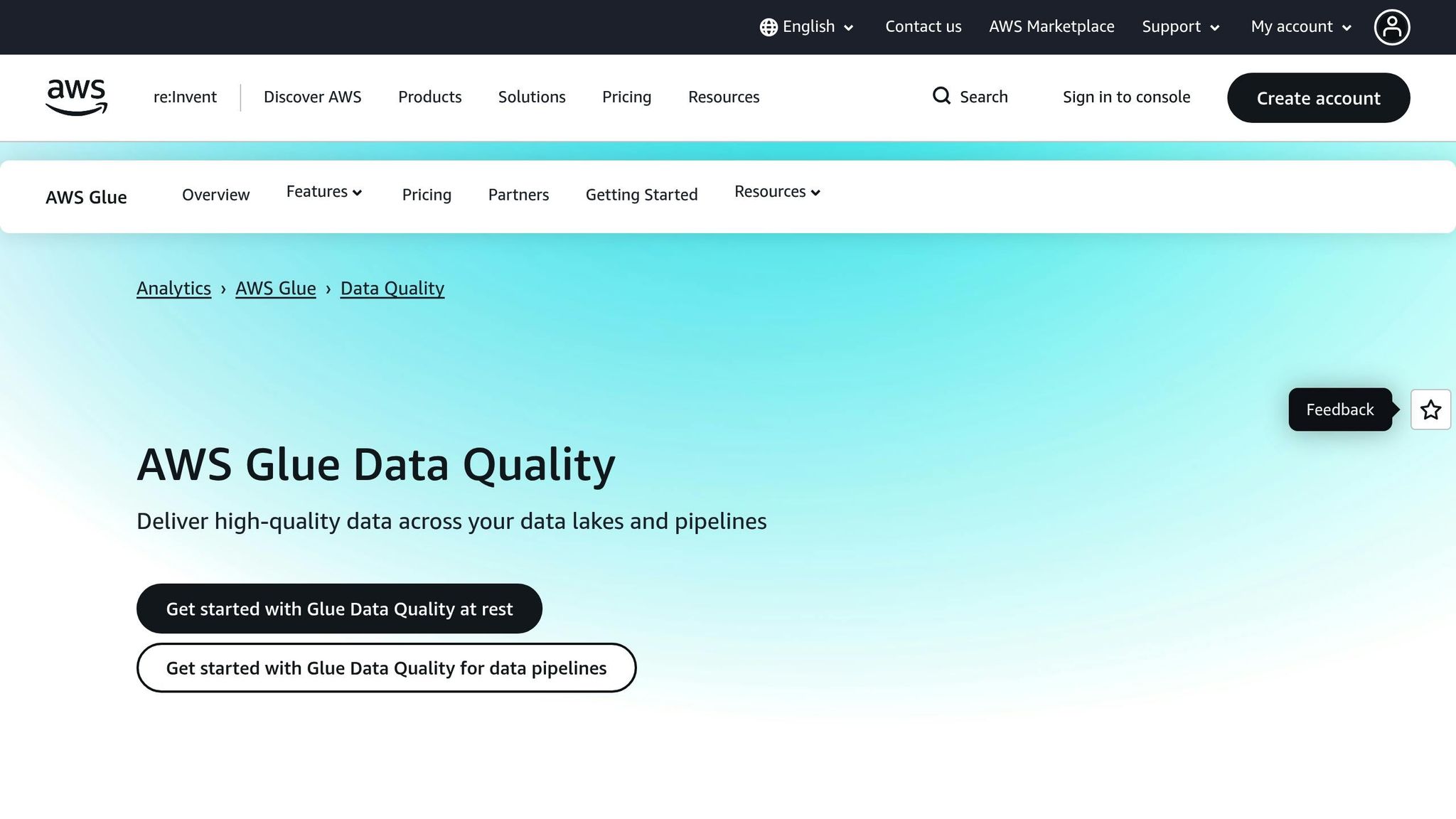ETL (Extract, Transform, Load) processes are the backbone of clean, reliable data for business decisions. They pull raw data from various sources, clean it, and load it into systems for analysis. Without ETL, businesses risk errors like duplicate records, inconsistent formats, or missing information, which can derail operations and cost millions annually.
Key Ways ETL Improves Data Quality:
- Extract: Gathers data from multiple sources, ensuring nothing is missed.
- Transform: Cleans and standardizes data (e.g., fixing date formats, removing duplicates).
- Load: Sends clean data to storage systems for use in analytics.
Common Data Quality Checks in ETL:
- Missing Data (NULL values): Identifies gaps in critical fields.
- Duplicate Records: Ensures data uniqueness to prevent inflated metrics.
- Format Validation: Confirms consistency in dates, currencies, and text patterns.
- Integrity Checks: Verifies relationships between datasets (e.g., orders linked to valid customers).
- Freshness: Ensures data is up-to-date for real-time decisions.
Automation and Monitoring:
- Automated tools streamline validation, detect errors in real-time, and isolate problematic records without disrupting workflows.
- Continuous monitoring tracks data flow and quality metrics, helping teams address issues quickly.
Takeaway: By integrating ETL with automated checks and monitoring, businesses can minimize errors, improve decision-making, and save resources.
Building Data Quality in ETL pipelines using AWS Glue Data Quality

Key Data Quality Checks in ETL Processes
ETL processes play a critical role in cleaning and preparing data, but without proper quality checks, errors can slip through and disrupt decision-making. These checks act as safeguards, ensuring only accurate and reliable data reaches your analytics systems. By understanding and implementing these essential tests, organizations can prevent costly mistakes tied to bad data.
Core Data Quality Tests
There are seven key data quality checks that every ETL process should include. Each one targets specific issues that commonly affect business data.
-
NULL values testing: This test identifies missing data in required fields. For instance, if your customer database lacks email addresses, marketing campaigns may fail to reach their intended audience. Sudden increases in NULL values often point to issues in data collection or upstream systems. Tools like dbt's
not_nulltest can automatically flag these gaps for review. - Volume tests: These checks compare expected and actual row counts to detect errors during data transfer. Discrepancies may indicate system malfunctions, incomplete transfers, or misconfigured connections.
- Uniqueness tests: Duplicate records can distort analytics. For example, multiple entries for the same customer might inflate customer counts or skew revenue figures. This test ensures that data remains free of duplicates.
- Referential integrity tests: These tests verify relationships between data tables. For example, every order in the "orders" table must correspond to a valid customer in the "customers" table. Orphaned records - like orders linked to nonexistent customers - can disrupt reporting and compliance.
- Numeric distribution tests: Logical anomalies in numeric data, such as negative prices or ages exceeding 150 years, can distort business analysis. These tests flag such irregularities before they cause problems.
- String patterns testing: Using regular expressions, this test ensures text data (e.g., email addresses, phone numbers, postal codes) adheres to expected formats. Invalid entries are flagged for correction or removal.
- Freshness checks: Timestamps confirm data is current. For instance, a daily sales report should only include transactions from the past 24 hours. Outdated data can mislead decision-makers, especially in fast-moving industries like e-commerce or finance.
Automated Data Validation
Automation has transformed data validation, replacing labor-intensive manual checks with scalable, efficient processes. Automated profiling tools continuously analyze data patterns, spotting anomalies and inconsistencies as data flows through the ETL pipeline.
These tools perform a range of checks - constraint validations, range checks, type verifications, and uniqueness tests - at every stage of the ETL process. By identifying where issues occur, they enable precise, targeted fixes.
For organizations managing large datasets, automation is essential. Manual checks simply can’t keep up with the scale or speed required. Automated systems not only handle high volumes but also ensure accuracy and completeness.
Real-time ETL processes benefit significantly from automated validation. Instead of waiting for batch cycles, streaming data is validated as it arrives, allowing immediate detection of quality issues and preventing bad data from accumulating downstream.
Another advantage is the automated isolation of problematic records. When issues are detected, automated systems can flag and isolate these records without disrupting the flow of good data. This ensures the pipeline continues running smoothly while problematic data is set aside for review and correction.
Continuous Monitoring
Maintaining data quality isn’t a one-time effort - it requires ongoing oversight. Continuous monitoring involves regular audits, historical analysis, and process improvements to catch gradual quality issues before they escalate.
Real-time observability platforms track data flow, transformation logic, and quality metrics throughout the ETL workflow. These platforms provide both technical and business-focused insights, helping teams link system issues to specific data quality problems.
Automated alerts and escalation procedures further enhance response times. By providing detailed context - such as data sources, processing rates, and quality metrics - teams can quickly identify root causes and implement fixes.
Trend analysis is another critical tool. By comparing current metrics (like accuracy, completeness, and timeliness) against historical benchmarks, organizations can spot gradual declines in data quality and address them proactively.
For BizBot, continuous monitoring is crucial to ensuring accurate financial transactions, user profiles, and service records. These elements must remain complete, current, and error-free to support reliable reporting and seamless user experiences.
Ultimately, monitoring efforts should align with business priorities, focusing on data quality issues that directly impact operations and decision-making, rather than arbitrary technical thresholds.
Data Cleansing and Standardization Methods
Once data issues are identified through rigorous quality checks, the ETL process steps in with cleansing and standardization techniques. These methods transform messy, inconsistent data into dependable datasets that can drive accurate business decisions. Without these steps, even the most advanced analytics tools can produce results that are misleading or outright incorrect.
Cleansing Methods
Data cleansing tackles the core issues that undermine data reliability. The process includes several targeted techniques:
- Data validation: This involves correcting errors, ensuring consistent formats, and removing anomalies.
- Deduplication: Duplicate records can distort analytics. Key-based matching is used for obvious duplicates, while fuzzy matching identifies less obvious ones.
- NULL handling: Missing critical information, flagged through not_null tests, is either replaced with default values or flagged for further review, depending on the context.
- Error correction: This addresses issues like typos and format inconsistencies.
- Outlier detection: Numeric data that falls outside logical ranges - like unrealistic ages or prices - can signal errors that need to be corrected before analysis.
A report from Airbyte Data Engineering Resources (2023) highlights how a major U.S. healthcare provider overhauled its ETL pipeline in 2022. By implementing automated data profiling and cleansing tools, they reduced duplicate patient records by 35% and improved billing accuracy by 22% in just six months. The project, spearheaded by their Chief Data Officer, included standardizing date formats and validating insurance codes, recovering $1.8 million in revenue.
Once these errors are resolved, the next step is standardization, which ensures that all data adheres to uniform formats for smooth integration.
Standardization Approaches
Standardization works hand-in-hand with cleansing by converting diverse data formats into consistent, usable forms. Here are some key methods:
- Date and time standardization: Dates from various sources, such as "MM/DD/YYYY" or "DD-MM-YYYY", are converted into a single format like "YYYY-MM-DD" to ensure uniformity across systems.
- Currency formatting: For organizations operating globally, monetary values are standardized. For example, all dollar amounts are formatted with two decimal places, and foreign currencies are converted to a base currency with documented exchange rates.
- Naming conventions: Standardizing labels like "customer_id" instead of a mix of terms such as "custID" or "client_identifier" ensures clarity and consistency across datasets.
- Data type consistency: Similar data elements, such as customer IDs, are converted to uniform types (e.g., strings), and date fields are aligned to a single timestamp format to avoid compatibility issues during analysis.
- Format alignment: This applies to data like phone numbers, addresses, and email formats. Regular expressions are often used to enforce patterns, such as "(XXX) XXX-XXXX" for phone numbers or validating email domains.
Automation Tools for Scale
Handling vast amounts of data manually is impractical, which is why automation is crucial for scaling cleansing and standardization processes while maintaining data quality. Automation tools bring efficiency and reliability to the table:
- Real-time monitoring: Platforms provide visibility into data workflows, tracking quality metrics and transformation logic to catch issues as they arise.
- Pre-built tests: Tools like dbt (data build tool) run automatic checks for missing data, duplicates, valid numeric ranges, and referential integrity.
- Data profiling: Automated profiling establishes baseline characteristics for datasets and tracks quality changes at different stages of the ETL process.
- String validation: Regular expression engines validate formats like emails and phone numbers across large datasets.
- Anomaly detection: Machine learning tools identify unusual numeric patterns by learning what "normal" data looks like and flagging deviations for review.
For organizations like BizBot, automation ensures that diverse data - such as financial transactions, user profiles, and service records - remains properly formatted and consistently standardized across systems.
Additionally, multi-layer validation applies checks at every stage of the ETL pipeline, from extraction to loading. This ensures errors are caught early, preventing flawed data from disrupting downstream analytics.
sbb-itb-d1a6c90
Best Practices for ETL Data Quality
Building a reliable ETL pipeline requires careful planning and execution to ensure dependable data outcomes.
Pre-ETL Data Assessment
Before diving into transformations, it's essential to understand your source data. This step acts as the foundation for maintaining quality and helps uncover issues early, where they’re easier - and cheaper - to fix.
Start by defining specific quality criteria that align with your business needs. Focus on key areas like accuracy, completeness, consistency, and timeliness. For example, critical fields might need near-total completeness, while financial data must be spot-on accurate. Setting measurable benchmarks ensures everyone knows what "good data" looks like.
Automated data profiling tools are invaluable here. These tools analyze your data structure and flag issues like outliers, missing values, or format mismatches before the ETL process even begins. By catching these problems early, you can avoid passing errors downstream. In fact, profiling and validating data at multiple ETL stages can cut downstream errors by up to 70%.
Another emerging practice is the use of data contracts. These contracts formalize expectations for data quality - like how complete or timely the data should be - ensuring they align with business objectives. Together, these assessments set the stage for effective documentation and collaboration.
Documentation and Compliance
Good documentation is the backbone of long-term data quality management. Keeping detailed records of your data sources, transformation rules, validation steps, and overall data flow is crucial - not just for day-to-day operations, but also for meeting regulatory requirements.
Tracking data lineage is particularly important. This process maps out how data moves through your ETL pipeline, making it easier to pinpoint where issues arise. If a quality problem pops up, lineage documentation helps teams trace it back to the source, saving time during audits or troubleshooting.
Security is another key piece of the puzzle. For instance, documenting how sensitive data - like Social Security numbers - is encrypted and how access is monitored ensures compliance with U.S. privacy laws. Industries like healthcare and finance, where regulations are stringent, rely heavily on this level of detail to demonstrate adherence to standards.
Working with Stakeholders
Beyond compliance, thorough documentation plays a critical role in fostering collaboration with stakeholders. Engaging with business teams ensures that data quality standards are practical and aligned with operational goals. For instance, finance teams might require all monetary values to be formatted in U.S. dollars with two decimal places, while HR might need employee records to include complete critical fields.
Regular communication between technical teams and business users is essential. Automated checks are great, but they can’t catch everything. Periodic reviews often uncover patterns or trends - like inconsistent naming conventions or unexpected data anomalies - that signal deeper problems with source systems or transformation logic. These reviews also provide a chance to adjust quality thresholds as business needs evolve.
Setting realistic quality standards is a collaborative effort. Different departments may have unique requirements for things like customer contact information. Feedback from users often highlights subtle issues, like inconsistent formatting, that automated tools might miss. Addressing these issues quickly builds trust and improves overall data quality.
Training programs can also help stakeholders understand how their input affects downstream analytics. This not only boosts collaboration but also reinforces the importance of maintaining high-quality data.
Lastly, tools like BizBot offer directories of business management solutions - covering areas like accounting, HR, and compliance - that integrate directly with ETL workflows. These platforms simplify data management and quality assurance, making it easier to meet organizational goals.
Meanwhile, data quarantine mechanisms ensure that problematic records don’t disrupt the entire ETL pipeline. By isolating and reviewing these records separately, you can keep the rest of the data flowing smoothly.
Manual vs Automated ETL Data Quality Methods
The choice between manual and automated methods for managing ETL data quality has a direct impact on the reliability of your data pipelines. Each approach comes with its own strengths and weaknesses, influencing how effectively your organization can maintain consistent, high-quality data.
Manual methods rely on tools like ad hoc queries, spreadsheets, and visual inspections. These methods are suitable for small datasets or one-off investigations but struggle with larger volumes and maintaining consistency. In traditional ETL environments, manual data quality checks can take up to 60% of a data engineer's time, leaving less capacity for more strategic tasks.
On the other hand, automated methods utilize specialized tools to perform systematic checks on data. These tools can identify null values, validate uniqueness, ensure referential integrity, and detect pattern violations - all without human intervention. Automated checks reduce error rates by up to 80% compared to manual processes, making them indispensable for large-scale operations.
As data volumes grow, the gap in performance between manual and automated methods becomes increasingly apparent. While manual checks may suffice for a few thousand records, they quickly become unmanageable when processing millions of transactions daily. This scalability challenge underscores the importance of automation for enterprise-level data quality management.
Comparison Table
| Criteria | Manual Methods | Automated Methods |
|---|---|---|
| Error Rates | Higher due to human oversight and fatigue | Lower with systematic, repeatable validation rules |
| Scalability | Limited to small datasets; requires more staff | Handles large datasets with minimal added cost |
| Resource Requirements | Labor-intensive; demands skilled personnel | Higher initial investment; minimal ongoing effort |
| Compliance & Auditability | Hard to document consistently; higher risk | Provides detailed logs for audits and compliance |
| Speed of Detection | Slow, with delays in issue resolution | Near real-time detection and correction |
| Flexibility | Adaptable for unique issues | Best for routine checks; may miss context-specific problems |
| Long-term Costs | High due to ongoing labor needs | Lower after initial setup |
| Monitoring Capability | Periodic reviews with potential gaps | Continuous monitoring with alerts and dashboards |
Both approaches have their place, and the key to maintaining high data quality often lies in combining them. Many organizations adopt a hybrid approach, using automation for routine checks while reserving manual reviews for edge cases or exploratory tasks. This balance ensures robust and scalable data management while addressing unique scenarios that automated tools might overlook.
Hybrid methods are particularly effective for managing sensitive data. Automated tools can enforce data masking, maintain encryption standards, and create detailed audit trails to meet regulations like HIPAA or SOX. For example, tools like BizBot connect ETL workflows with accounting, compliance, and subscription management, offering a comprehensive solution for data quality oversight.
Ultimately, your choice should align with your specific needs. Small teams working with static datasets may find manual methods sufficient, but organizations dealing with real-time data streams will see significant benefits from automated solutions that scale with their growth.
Conclusion: Continuous Improvement and Monitoring
Ensuring high-quality data through ETL processes isn't a one-and-done effort - it’s an ongoing journey. It requires consistent monitoring and well-documented workflows to support improvements over time. As data sources evolve, business needs shift, and regulations change, your ETL data quality strategy must keep pace to remain effective.
Take the financial services industry as an example. One company uncovered recurring transaction data errors during routine audits. The culprit? Inconsistent date formats across different data sources. By introducing automated validation and standardization checks, they cut data errors by 80% and significantly improved reporting accuracy. This not only bolstered regulatory compliance but also strengthened customer trust. This example highlights the power of real-time validations in managing evolving data landscapes.
Real-time monitoring has become essential for modern ETL operations. Automated systems can reduce data errors by up to 40% and speed up issue resolution by 30%. These tools help data teams catch problems like missing values, format mismatches, or unexpected anomalies before they disrupt downstream analytics.
Setting clear, measurable standards is another critical step. For instance, industry best practices suggest thresholds like allowing no more than 2% of records to be incomplete in any dataset. These benchmarks make it easier to evaluate ETL performance and pinpoint areas for improvement.
Sustaining data quality requires a combination of recurring audits and automated observability tools. Together, these approaches provide immediate issue detection while offering long-term insights into trends.
For organizations juggling multiple business functions, platforms like BizBot can further enhance ETL data quality efforts. These tools offer centralized dashboards for tracking metrics, automating compliance checks, and promoting collaboration among stakeholders. This kind of integration ensures consistent oversight across all data-driven operations and fosters a culture of ongoing improvement.
Key Takeaways
Achieving top-notch ETL data quality revolves around three core principles: automation, measurement, and adaptability.
- Automate routine quality checks to catch errors quickly and reliably.
- Set clear benchmarks to measure progress and identify weak spots.
- Engage stakeholders through cross-functional collaboration to drive meaningful changes.
- Embed continuous improvement into your ETL workflows to stay ahead of evolving challenges.
Organizations that adopt these practices gain better decision-making capabilities, stronger compliance, and greater confidence in their data assets.
FAQs
How does the ETL process help eliminate data errors like duplicates and missing values?
The ETL process - Extract, Transform, Load - is essential for refining data quality by tackling common issues like duplicates and missing (NULL) values. In the Transform stage, data undergoes cleansing to eliminate duplicate records, address gaps by filling in missing values when feasible, and maintain consistency across datasets.
ETL tools also play a key role in standardizing data formats, validating information against predefined rules, and enforcing integrity constraints. This ensures the resulting dataset is accurate, complete, and primed for analysis. With such a structured approach, businesses can confidently rely on their data to drive informed decisions.
How does automation improve data quality in ETL processes compared to manual methods?
Automation is a game-changer for improving data quality in ETL (Extract, Transform, Load) processes. It cuts down on human error, enforces consistency, and handles large datasets with ease. Automated tools can apply standardized cleaning and transformation rules while validating data accuracy in real-time - something that's tough to achieve manually.
Unlike manual methods, automation streamlines workflows, reduces inconsistencies, and delivers dependable, repeatable results. This makes it a powerful tool for companies aiming to maintain high-quality data as they scale. With automated ETL solutions, businesses can shift their focus to making smarter, data-driven decisions instead of getting bogged down in repetitive tasks.
Why is continuous monitoring important for maintaining data quality in ETL pipelines, and what are the best practices to ensure effective oversight?
Continuous monitoring plays a key role in ETL pipelines, ensuring data remains accurate, consistent, and reliable at every stage. By keeping a close eye on the process, you can catch issues like missing values, duplicate records, or incorrect formatting before they affect downstream systems or decision-making.
To uphold strong data quality, it’s smart to use automated validation checks, anomaly detection, and real-time alerts. Tools that offer detailed logging and reporting can also give you valuable insights into pipeline performance, helping you spot areas that need attention. On top of that, conducting regular audits and updating data quality rules ensures your pipeline stays aligned with evolving business requirements.


